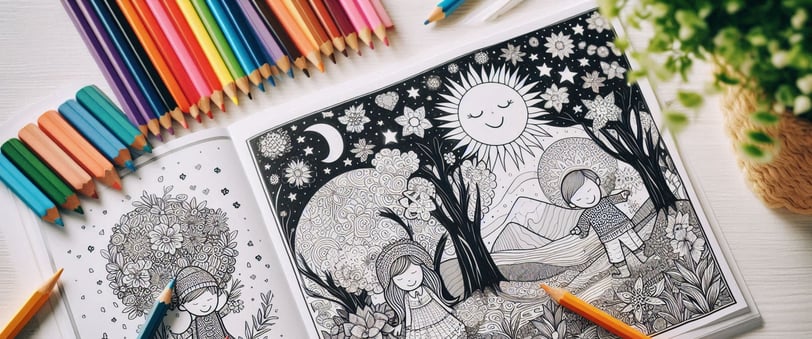The History of Coloring Books
Coloring books have been a beloved pastime for children and adults alike for many years. These books provide an opportunity for creative expression, relaxation, and learning. The journey of coloring books from their origins to their modern-day versions is a fascinating tale of cultural and technological evolution. Let’s explore the history of coloring books and see how they have evolved over the years.
Andrea Steed
7/20/2024


Early Beginnings
The concept of coloring books can be traced back to the 19th century. One of the earliest known coloring books is "The Little Folks' Painting Book," published in the 1880s by the McLoughlin Brothers, a New York-based publishing company. These early books were not entirely like the ones we know today. Instead of being printed with outlines to be filled in, they were often designed for children to paint directly onto the pages, using watercolors.
Rise in Popularity
Coloring books gained popularity in the early 20th century. In 1907, the Crayola company introduced their famous crayons, which made coloring more accessible and enjoyable for children. The availability of affordable crayons coincided with the production of more intricate and themed coloring books. These books often featured simple line drawings and were marketed as educational tools, helping children learn about subjects like animals, geography, and history.
Mid-20th Century Boom
The mid-20th century saw a significant increase in the variety and popularity of coloring books. During the 1950s and 1960s, coloring books became a common promotional tool for brands and entertainment companies. Popular characters from television, movies, and comic books began to appear in coloring books, further boosting their appeal. Companies like Whitman Publishing produced a wide range of licensed character coloring books featuring beloved icons such as Mickey Mouse, Superman, and Barbie.
Educational and Therapeutic Uses
In the late 20th century, the role of coloring books expanded beyond entertainment. Educators and psychologists began to recognize the benefits of coloring for children’s cognitive and motor skill development. Coloring books were increasingly used as educational tools, helping children develop fine motor skills, hand-eye coordination, and color recognition.
The therapeutic benefits of coloring also became evident. Coloring was found to have calming effects, reduce stress, and provide a creative outlet for children and adults alike. This led to the development of coloring books specifically designed for relaxation and therapy, often featuring intricate patterns and mandalas.
Digital Age and Modern Trends
The advent of digital technology in the 21st century brought new dimensions to coloring books. Digital coloring books and apps became available, allowing users to color on tablets and smartphones. These digital versions often include interactive features, such as the ability to change colors with a tap or zoom in for detailed work.
Despite the rise of digital coloring, traditional coloring books remain popular. The trend of adult coloring books emerged in the early 2010s, driven by the recognition of coloring’s therapeutic benefits for adults. These books feature complex designs and themes tailored to adult tastes, such as intricate floral patterns, cityscapes, and abstract art.
Conclusion
The history of coloring books is a testament to their enduring appeal and versatility. From their early days as simple painting books to their current forms as educational tools and stress-relief aids, coloring books have evolved to meet the changing needs and interests of society. Today, they continue to be a beloved activity for people of all ages, offering a delightful blend of creativity, learning, and relaxation. As we look to the future, it’s clear that coloring books will remain a cherished pastime, continuing to inspire and entertain generations to come.
© 2024. All rights reserved.


